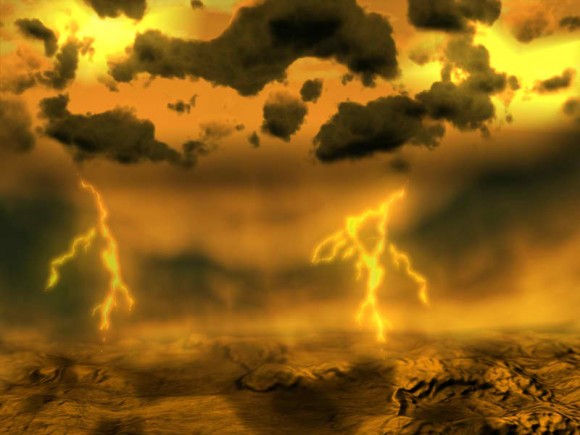The Venus Express spacecraft, which is in orbit around Venus, has already studied the lightning phenomenon on Venus in detail using its magnetometer, it examined the discharge rates of the electric charge, the density and the spatial distribution of the lightning in the magnetic field, at altitudes between 200 and 500 km.

Venus is a world not for the faint of heart. On the surface you had to withstand intensely high temperatures, air pressure of a thick atmosphere composed of sulfuric acid. In addition you had to deal with lightning and storms. These storms are surprisingly similar to lightning storms on Earth, despite the large differences between the two planets' atmospheres. "Venus and Earth are often called twin planets because of the similarity in size, mass and internal structure," says Dr. Christopher Russell of the University of California, who presented his findings at the European Planetary Science Congress in Rome this week. "The creation of lightning is one of the ways in which Venus and Earth are seen to be twins, although not identical."
Scientists have known that there is lightning on Venus since the first planetary missions there such as Venera and Venus Pioneer. The Galileo spacecraft also reported electromagnetic waves emitted from Venus that could be produced by lightning. This fact has also been verified by ground-based telescopes that have photographed flickering lights on Venus.
Now, the Venus Express spacecraft, which is in orbit around Venus, has already studied the lightning phenomenon in Venus in detail using its magnetometer, it examined the discharge rates of the electric charge, the density and the spatial distribution of the lightning in the magnetic field, at altitudes between 200 and 500 km.
Russell said that the electromagnetic signals in Venus' atmosphere associated with lightning discharges are stronger than signals on the ground at these frequencies because the background magnetic field is much weaker and the waves travel more slowly, but the flux of electromagnetic energy is similar to that on Earth.
Strong, short pulses of signals supposed to be produced by lightning were seen almost as soon as the spacecraft arrived at Venus. And this despite the generally bad orientation for the entry of signals into the ionosphere of Venus, a place where Venus Express conducts the dimensionality." Russell said.
The electromagnetic waves are strongly guided by Venus' magnetic field, and can only be detected by the spacecraft when the magnetic field is tilted more than 15 degrees horizontally. This is in stark contrast to the situation on Earth, where lightning signals are aided in entering the ionosphere by the nearly vertical magnetic field.
When clouds form, on Earth or Venus, the solar energy stored in the air can be released in a powerful electrical discharge. When the cloud particles collide, they transfer electrical charge to large and small particles, with large particles tending to fall while small particles drift upward. The separation of the charges leads to a lightning strike. This process is important to the atmosphere because it causes the temperature and pressure in small areas of the atmosphere to rise to a high value, so that molecules can form, something that would not otherwise occur. This is why scientists believe that lightning played an important role in helping life form on Earth.
"We analyzed 3.5 Earth years of lightning data on Venus using low-altitude Venus Express data collected for about XNUMX minutes each day," Russell said. "By comparing electromagnetic waves produced on the two planets, we found strong magnetic signals on Venus, but when we convert this to energy flux terms we found that the lightning intensity is similar," Russell said.
It also seems that lightning is more common on the day side of the planet than on the night side, and occurs more often in low Nogai latitudes where the sun heats the atmosphere more strongly."

One response
Amazing star!